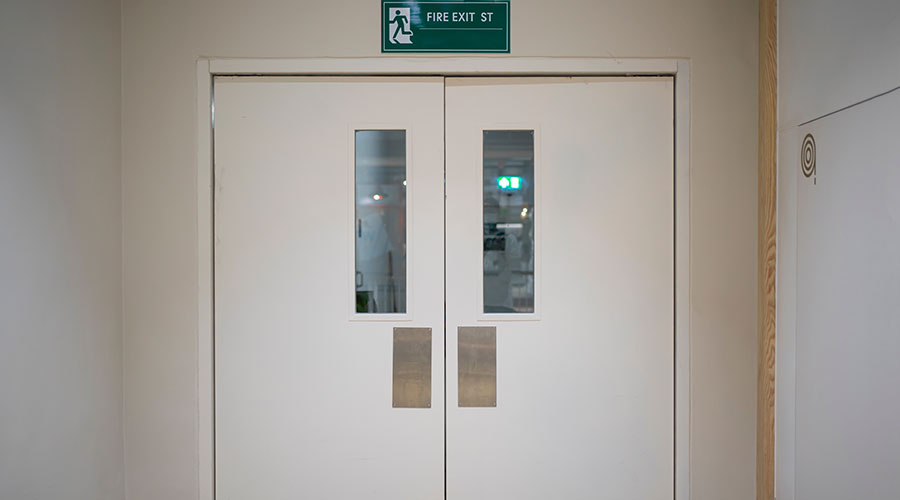Accessibility is a must for healthcare facilities of all types, and doors present a potential barrier to entry. Fortunately, there are many doors that are designed with accessibility in mind and are ADA compliant. In this manufacturer roundtable, Healthcare Facilities Today speaks with door manufacturers about what door hardware exists to help with accessibility for people who need it.
What door hardware exists to help increase accessibility in healthcare facilities to those who need it?
“ADA compliant hardware is required in most commercial settings, meaning no pinching, twisting or grasping to operate the hardware and limitations on the force needed to operate the hardware along with clearance requirements. Operating force of the doors is another consideration that intersects with ADA and accessibility and affects door closing devices. To go beyond code minimums, projects may seek closers with lower levels of operating force or hospital latches which can facilitate ease of operation and movement through a swing door.
With sliding doors, many hardware options are designed to be easily operable for those with mobility differences (i.e. fixed pull handles that do not require rotation) and the motion of the door leaf itself can enhance accessibility for those who use assistive devices. Automatic operators provide another level of accessibility, allowing users to operate a door with the push of a button or the wave of a hand, giving them ample time to cross through an opening while the door closes automatically behind them. This makes them an excellent feature for projects striving towards universal design.”
— Tysen Gannon, business development and marketing consultant, AD Systems
“Several types of door hardware exist to increase accessibility in healthcare facilities:
- Automatic doors are generally doors that are actuated by electric motors.
- The automatic opening and closing actions are triggered by either motion sensors, or "knowing act" devices such as push plates or touchless wave sensors.
- Most automatic doors fit under two broad categories of doors: swing-type (doors that pivot open) or sliding-type (doors that slide a panel out of the path of travel).
- Automatic doors are especially useful for individuals with mobility or strength impairments who may struggle with manually opening traditional doors.
- Automatic doors make it easier for mobility impaired individuals to open and close doors and make it easier for those who are helping mobility impaired individuals to move throughout paths of travel.
- Related to automatic doors are "power-assisted" doors which utilize electric motors or springs to make doors feel lighter to operate.
- ADA-compliant door handles are generally lever type handles that are easier to use than a traditional doorknob.
- Increasing the width of doorways and doors in facilities can improve accessibility for individuals using mobility aids such as wheelchairs or walkers. ADA guidelines recommend a minimum clear width of 32 inches for accessible doorways.”
— Brian Ha, product manager, STANLEY Access Technologies
“Door hardware options such as the Push-N-Go automatic activation work by pushing or pulling the door panel gently which will initiate the opening of the door. Touchless Activation activates the door without the need of handling the door panel in any way.
In line with ADA Standards for Accessible Design, the CL400 ADA Magnetic has a handle that is easy to grasp with one hand and does not require tight grasping, tight pinching or twisting of the wrist. The opening force required to operate the unit is 2.5lbf (11.1N), which is under the 5lbf threshold for ADA compliance.
The CL100 ADA Indicator Lock is a disabled access lockset designed with ease of use and longevity of service in mind. Brass and stainless-steel working components ensure reliability. The Indicator Lock is self-latching and utilizes ‘fail safe’ single action egress functionality. The lock has a lever that is easy to grasp with one hand and does not require tight grasping, tight pinching or twisting of the wrist. The opening force required to operate the unit is less than 5lbf (22.2N), which is under the threshold for ADA compliance.”
— Ashley Estrada, product manager, Horton Automatics
Jeff Wardon, Jr. is the assistant editor for the facilities market.

 UF Health Hospitals Rely on Green Globes to Realize Their Full Potential
UF Health Hospitals Rely on Green Globes to Realize Their Full Potential How Healthcare Facilities Can Be Truly Disaster-Resilient
How Healthcare Facilities Can Be Truly Disaster-Resilient TriasMD Breaks Ground on DISC Surgery Center for San Fernando Valley
TriasMD Breaks Ground on DISC Surgery Center for San Fernando Valley Bigfork Valley Hospital Falls Victim to Data Breach
Bigfork Valley Hospital Falls Victim to Data Breach AI-Driven Facilities: Strategic Planning and Cost Management
AI-Driven Facilities: Strategic Planning and Cost Management